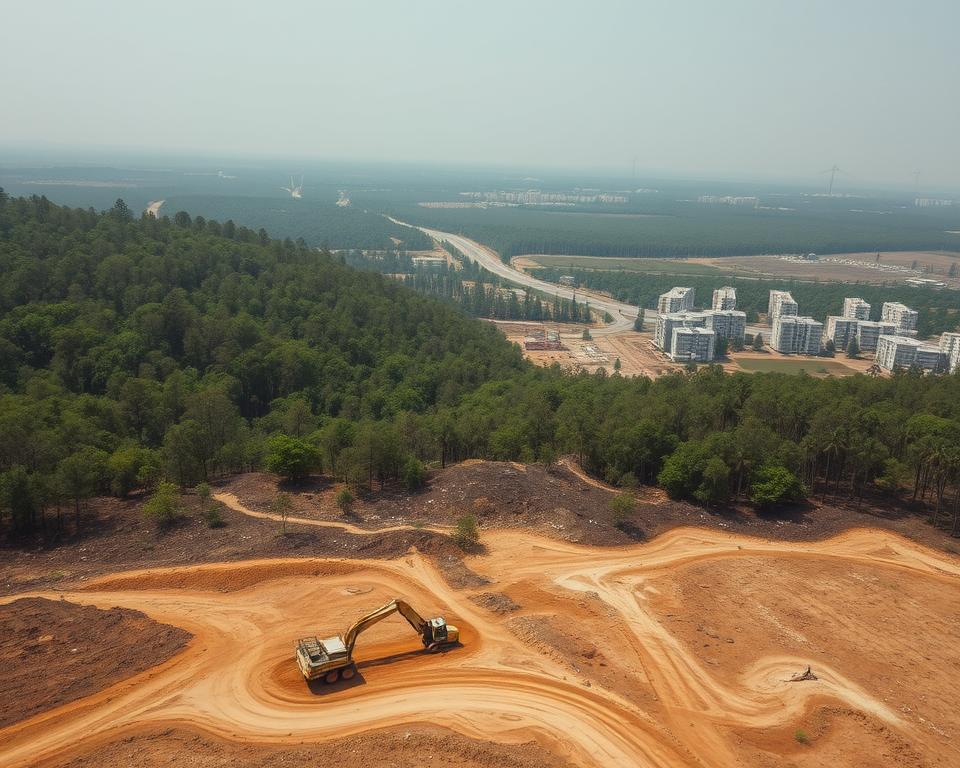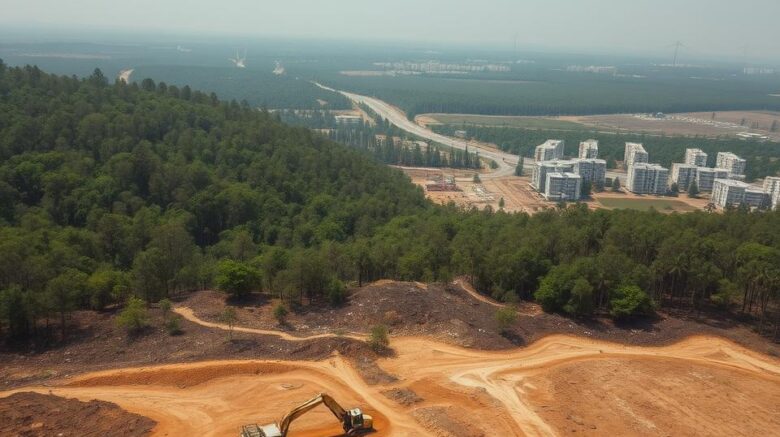Land Clearing Encircling Water Sources: Optimal Methods
Research shows nearly 70% of the world’s fresh water supplies are endangered due to agricultural runoff and Land Clearing? Such a startling statistic calls attention to the critical need for responsible land management, essential during water source Land Clearing. Ensuring environmental stewardship is central to upholding ecological balance and preserving water quality and wildlife habitats. With increasing resource demands from communities, utilizing sustainable land management practices is indispensable. This approach promotes project success while mitigating soil erosion and minimizing pollution threats in aquatic ecosystems – land clearing services.
Primary Conclusions
- Implementing eco-conscious land management is critical to shielding water quality.
- Implementing best practices can prevent soil erosion and habitat loss.
- Recognizing ecological impacts is essential for responsible Land Clearing.
- Proper planning enhances project success while safeguarding ecosystems.
- Utilizing effective techniques promotes biodiversity in aquatic landscapes.
Understanding the Importance of Sustainable Land Clearing
Land Clearing is not limited to plant removal. It has environmental impacts of Land Clearing that can affect adjacent zones, particularly aquatic ones. Conventional approaches typically lead to soil erosion, habitat disruption, and water contamination. Recognizing these impacts is essential for embracing superior land management.
Environmental Impacts of Standard Land Clearing
Standard Land Clearing methods can cause many environmental issues. Soil erosion happens when vegetation is lost, degrading soil and causing sediment runoff into water. These sediments pollute water, affecting aquatic ecosystems. It also threatens local wildlife and disrupts the ecosystem’s balance.
Eco-friendly Land Management Alternatives
Adopting sustainable land management practices offers a solution to traditional clearing’s problems. Selective clearing—targeted removal of certain vegetation—maintains ecological equilibrium. Applying erosion control tactics, including cover crops, fortifies soils and maintains water quality. Focusing on native plants supports fauna and enhances ecosystem health.
Essential Best Practices for Land Clearing
Successful clearing projects hinge on a solid understanding of ecological factors. It’s vital to assess environmental goals to ensure clearing efforts are effective and sustainable. With defined objectives, landowners can make choices that align environmental protection with development priorities.

Measuring Environmental Aims
Before a clearing project, one must appraise environmental goals. It requires examining the local ecosystem and clearing’s potential impacts on fauna, soils, and water. Defining personal objectives aids in crafting strategies to safeguard local habitats and watersheds.
Choosing the Right Time for Clearing
The scheduling of clearing activities influences success greatly. Clearing during winter or early spring—when soils are frozen—minimizes disturbance and erosion. Avoiding clearing at wrong times promotes healthier terrains and reduces ecological harm.
Understanding Local Clearing Regulations
Adhering to local Land Clearing rules is vital for project success. Familiarity with permits sidesteps legal issues and fines. It’s wise to check local ordinances, even near protected areas, to avoid environmental disasters from unapproved clearing.
Land Clearing Adjacent to Hydric Zones: Best Practices
Clearing strategies around aquatic sources emphasize safeguarding sensitive zones and preserving ecological equilibrium. This comprehensive method entails pinpointing areas needing extra care and applying suitable erosion control measures. These measures are essential for safeguarding biodiversity and upholding water purity.
Identifying Sensitive Areas that Need Protection
Before initiating Land Clearing, it is essential to assess the landscape for sensitive areas such as wetlands and riparian zones. These unique ecological zones play a vital role in filtering pollutants and providing habitat for various species. By accurately mapping these zones, land managers can plan protective strategies before and after clearing.
Applying Erosion Control Techniques
Once sensitive areas have been identified, effective erosion control methods must be employed to minimize sediment runoff into adjacent water bodies. Using silt barriers, buffer strips, and cover crops greatly aids in water quality protection. Combining sustainable clearing and erosion controls promotes a robust ecosystem near water sources. These efforts benefit ecosystems and nearby communities alike.
Comparing Mechanical and Manual Clearing
Selecting mechanical or manual clearing is key. Each has its own set of advantages and disadvantages, affecting the environment and the clearing process’s efficiency. Recognizing these variations enables informed decision-making aligned with management aims.
Mechanical Clearing: Benefits and Drawbacks
Mechanical Land Clearing employs heavy machinery to swiftly remove trees, shrubs, and debris. It leads to quicker project completion and less physical labor. However, heavy equipment may disturb soils, cause compaction, and harm ecosystems.
- Pros: Rapid clearing of expansive zones.
- Decreased labor requirements.
- Ability to handle tough terrain.
- Drawbacks: Heightened environmental footprint.
- Possibility of increased erosion.
- Potential habitat damage.
Benefits of Manual and Selective Clearing
Manual, selective clearing prioritizes ecological preservation. Using trained workers, targeted removal reduces soil disruption and safeguards vegetation. This method is ideal when maintaining biodiversity and ecological health are key.
- Advantages: Protection of native flora.
- Reduced soil disturbance and erosion.
- Strengthened habitat protection for fauna.
Wetland Clearing Techniques
Wetland ecosystems are distinctive habitats vital for ecosystem stability. They purify water, mitigate flooding, and serve as habitats for diverse life forms. Grasping wetland ecology is critical for responsible clearing. The objective is to lessen disruptions and maintain these aquatic habitats.
Understanding Wetland Ecosystems
Wetlands are defined by distinct water regimes, soils, and plant communities. They serve as transitional zones between terrestrial and aquatic environments, supporting a variety of wildlife. They regulate water quality via natural filtration processes that extract contaminants. Maintaining wetland health fosters biodiversity and ecological durability.
Techniques for Responsible Wetland Clearing
Thoughtful planning and execution are required for responsible wetland clearing. Eco-conscious strategies lessen clearing’s ecological damage. Commonly used strategies include:
- Staging Operations: Conduct clearing in phases to minimize ecological disruption, allowing time for wildlife to adapt.
- Selective Clearing: Remove only specific vegetation types, preserving critical species for habitat stability.
- Encouraging Regrowth: Introduce practices that encourage natural vegetation regrowth after clearing, maintaining ecosystem functions.
- Buffer Zones: Establish buffer areas around sensitive wetland sections to protect aquatic habitats from disturbances.
Adopting these techniques ensures that responsible wetland clearing supports the ecological functions wetlands provide while reducing the risk of habitat destruction.
Safeguarding Riparian Reserves in Clearing
Riparian buffer zones are key to aquatic ecosystem health. Situated along watercourses, they serve as natural protective buffers. They safeguard water quality and enhance biodiversity. With best practices, managers avoid erosion, conserve wildlife habitats, and uphold waterway ecology.
Role of Riparian Buffers in Aquatic Ecosystems
Riparian buffers are key to supporting aquatic ecosystems. They filter pollutants, stabilize shorelines, and provide habitats for various species. They serve as barriers that lessen human impact on aquatic systems. Protecting riparian areas enhances water quality, supports fish populations, and strengthens ecosystem resilience.
Essential Riparian Zone Maintenance Practices
To keep riparian reserves effective, several best practices are essential:
- Avoid construction within buffer strips to minimize disturbance.
- Use native vegetation to stabilize banks and prevent erosion.
- Establish a diverse plant community to enhance habitat complexity and support wildlife.
- Manage invasive species to protect native plants and maintain ecosystem stability.
- Regularly assess soil health and water quality to guide management efforts.
Importance of Aquatic Land Clearing Strategies
Aquatic clearing strategies help maintain ecosystem harmony and water quality. Ensuring water quality control during clearing cuts pollution threats and fosters sustainability. These strategies prevent sediment runoff and improve aquatic ecosystem health.
Evaluating Water Quality and Sediment Control
Proper water quality control begins with evaluating local water systems. Clearing adjacent to water systems must avoid sediment deposits that damage water quality and aquatic organisms. Strategies include:
- Establishing buffer zones to filter pollutants
- Using sediment traps and barriers to minimize runoff
- Selecting clearing times to coincide with low water levels
These practices shield water quality and sustain ecosystem health. Residual vegetation aids in sediment control and nutrient cycling, leading to healthier waterways.
Promoting Biodiversity in Aquatic Landscapes
Preserving biodiversity in water-adjacent landscapes is critical for ecosystem resilience. Clearing near water must safeguard indigenous species crucial to habitats. Steps to boost biodiversity include:
- Conserving critical habitats during clearing processes
- Implementing phased clearing to allow wildlife adaptation
- Restoring natural vegetation post-clearing to enhance habitat
Embracing these tactics enables managers to nurture biodiversity in water-adjacent areas. This leads to more robust and adaptable ecosystems. Such measures defend water quality and encourage sustainable land management.
Considerations for Stream Bank Clearing
Stream bank clearing presents specific challenges that demand ecological and regulatory consideration. Respecting riverbank guidelines is vital to maintain water source ecosystem balance. Erosion, habitat loss, and water quality degradation necessitate strategic mitigation during clearing.
Stream Bank Clearing Challenges
Stream bank clearing involves various challenges. Erosion poses significant risks, leading to soil depletion and declining water quality. Habitat disruption impacts local wildlife, which depend on riparian zones. Without natural vegetation, stormwater runoff increases, leading to sedimentation in waterways. These issues highlight the need for effective management of stream bank areas.
Erosion Mitigation and Flora Support
Erosion control is essential in stream bank clearing. Using indigenous vegetation fortifies banks. Their roots combat soil erosion, fostering a sustainable environment for local flora and fauna. Periodic reviews in clearing guarantee efficacy and preserve riverbank ecology. Healthy vegetation supports land management goals and ecological integrity.
In Closing
Following best practices in water source Land Clearing is critical to ecosystem well-being. Stakeholders need to prioritize sustainable land management. This approach not only fulfills their goals but also protects the environment. Thoughtful planning and execution guarantee that clearing preserves aquatic ecosystems and biodiversity.
Locating sensitive zones and applying erosion controls are fundamental steps. Employing both mechanical and manual clearing methods helps landowners and contractors achieve responsible land management. Sustainable practices foster harmony between development and nature. This maintains vibrant, resilient water sources and adjoining landscapes.
The commitment to sustainable land management is a collective responsibility. Each clearing activity influences watershed health. By adopting eco-friendly methods, we enable a future where farming and environments thrive together.
